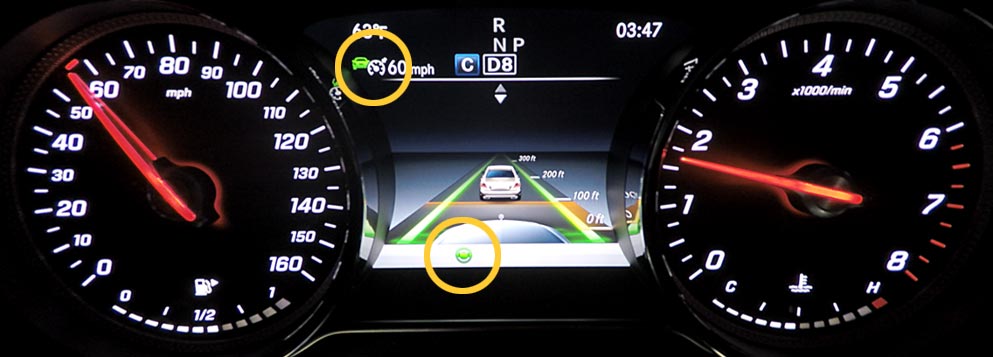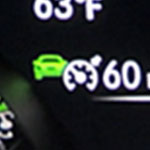New studies highlight driver confusion about automated systems
June 20, 2019

Vehicles are getting increasingly sophisticated, with more and more of them able to stay in a lane and maintain a set speed and following distance with minimal driver input. But this kind of automation has limitations that can be tricky for drivers to grasp, and two new IIHS studies highlight misperceptions or gaps in drivers' understanding.
One study revealed how the names manufacturers use for these systems can send the wrong messages to drivers regarding how attentive they should be. Another found that drivers don't always understand important information communicated by system displays.
"Current levels of automation could potentially improve safety," IIHS President David Harkey says. "However, unless drivers have a certain amount of knowledge and comprehension, these new features also have the potential to create new risks."
The automation available in vehicles available for purchase today is considered Level 1 or 2, which applies to systems that can perform one or more parts of the driving task under supervision of the driver. An example of a Level 1 system is lane centering, in which lateral control of the vehicle is automated, or adaptive cruise control, in which longitudinal control — i.e. speed and following distance — is automated. Systems that can perform both of those functions simultaneously are Level 2 systems.
These systems are a far cry from Level 5 automation, in which the entire driving task can be performed without input from a human under all conditions.
Levels of driving automation
(developed by SAE International)
| Level 0 | The human driver does everything. |
|---|---|
| Level 1 | An automated system can assist the human driver in conducting one part of the driving task. Available on vehicles that can be purchased today. |
| Level 2 | An automated system can assist the driver with multiple parts of the driving task. The driver must continue to monitor the driving environment and be actively engaged. Available on vehicles that can be purchased today. |
| Level 3 | An automated system conducts all of the driving task without driver engagement and monitors the driving environment, but the human driver must stand by to intervene in response to a system failure or request from the system to take over. |
| Level 4 | An automated system can conduct the entire driving task without driver input but only in certain conditions (e.g., limited to 25 mph) or places (e.g., a city center). |
| Level 5 | An automated system can perform the entire driving task without driver input under all conditions |
System names
Despite the limitations of today's systems, some of their names seem to overpromise when it comes to the degree to which the driver can shift their attention away from the road. One name in particular — Autopilot — signals to drivers that they can turn their thoughts and their eyes elsewhere, an IIHS survey found.
For the survey, more than 2,000 drivers were asked about five Level 2 system names currently on the market. The names were Autopilot (used by Tesla), Traffic Jam Assist (Audi and Acura), Super Cruise (Cadillac), Driving Assistant Plus (BMW) and ProPilot Assist (Nissan). Participants were told the names of the systems but not the vehicle brands associated with them and weren't given any other information about the systems.
None of these systems reliably manage lane-keeping and speed control in all situations (see "IIHS examines driver assistance features in road, track tests," Aug. 7, 2018). All of them require drivers to remain attentive, and all but Super Cruise warn the driver if hands aren't detected on the wheel. Super Cruise instead uses a camera to monitor the driver's gaze and will issue a warning if the driver isn't looking forward.
Each participant answered questions about two of the systems chosen at random. They were asked whether particular behaviors were safe while using that technology.
When asked whether it would be safe to take one's hands off the wheel while using the technology, 48 percent of people asked about Autopilot said they thought it would be, compared with 33 percent or fewer for the other systems. Autopilot also had substantially greater proportions of people who thought it would be safe to look at scenery, read a book, talk on a cellphone or text. Six percent thought it would be OK to take a nap while using Autopilot, compared with 3 percent for the other systems.
Percent of drivers who considered behaviors safe while Level 2 system is in operation
At least a few Tesla owners have been misusing Autopilot in this way, with fatal results.
In March, a Tesla driver crashed into the side of a tractor-trailer in Florida. The Model 3 went completely under the truck, shearing off the Model 3's roof and killing its driver. A preliminary investigation by the National Transportation Safety Board found that Autopilot was engaged at the time of the crash, and the driver's hands were not detected on the steering wheel.
The same was true in the crash of a Tesla Model X in California one year before (see "Fatal Tesla crash highlights risk of partial automation," Aug. 7, 2018) and a 2016 Florida crash of a Model S that also involved the side of a tractor-trailer.
"Tesla's user manual says clearly that the Autopilot's steering function is a ‘hands-on feature,' but that message clearly hasn't reached everybody," Harkey says. "Manufacturers should consider what message the names of their systems send to people."
Instrument cluster information
If a system name is one of the first ways a driver learns about a feature, another source of information is the instrument cluster. Displays are important because they tell a driver how a system is responding to situations or when a system is temporarily inactive. For example, a lead vehicle may disappear from the display when that vehicle is cresting a hill and no longer detected by the system's radar. Similarly, lane lines may disappear from the display when the lane markings on the road are no longer visible to the system's cameras.
The second recent IIHS study looked at whether drivers understand this information from the display of a 2017 Mercedes-Benz E-Class with the Drive Pilot system. The E-Class display is typical of displays from other automakers.
Eighty volunteers viewed videos recorded from the driver's perspective behind the wheel of the E-Class. The participants were asked about the operating status of the adaptive cruise control and lane-centering features. If the features were inactive, the participants were asked to explain why. Half of the participants first received some training in the form of a brief orientation about the instrument cluster icons pertaining to the two systems.
Understanding these displays is important because automated systems can behave unexpectedly (see "IIHS examines driver assistance features in road, track tests," Aug. 7, 2018) and changing circumstances may require the driver to intervene.
2017 Mercedes-Benz E-Class with Drive Pilot dash display



In the study, certain key pieces of information eluded many of the participants. While almost everyone was able to understand when adaptive cruise control had adjusted the vehicle speed or detected another vehicle ahead, most participants, regardless of whether they received the training, struggled to understand what was happening when the system didn't detect a vehicle ahead because it was initially beyond the range of detection.
Most of the people who didn't receive training also struggled to identify when lane centering was inactive. In the training group, many people got that right. However, even in that group, participants often couldn't explain why the system was temporarily inactive.
"If your Level 2 system fails to detect a vehicle ahead because of a hill or curve, you need to be ready to brake. Likewise, when lane centering does not work because of a lack of lane lines, you need to steer," says Harkey. "If people aren't understanding when those lapses occur, manufacturers should find a better way of alerting them."
Some systems use audible alerts in those situations in addition to visual signals. That may help, but drivers often find audible alerts annoying. Another option is making the pertinent visual signal more obvious and understandable.
Although systems ideally should be intuitive, providing an orientation at the dealership could also help. The study showed that interface-specific training helped drivers notice changes in lane-centering activity and use the correct icons to determine system status.